![]()
![]()
![]()
Use LEFT and RIGHT arrow keys to navigate between flashcards;
Use UP and DOWN arrow keys to flip the card;
H to show hint;
A reads text to speech;
8 Cards in this Set
- Front
- Back
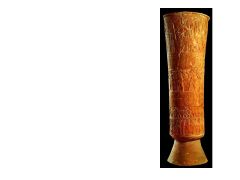
What when where art historic significance?
|
Warka Vase from Uruk (modern Warka) Iraq ca. 3,200-3,000 B.C.E.
alabaster approximately 3 ft. high First great work of narrative relief sculpture known. Depicts a religious festival in honor of Inanna Registers…. Ground lines…. Hierarchy of scale |
|
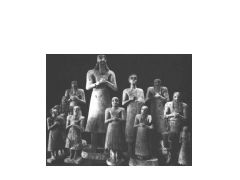
What, when, where, art historic significance?
|
Statuettes of worshippers
from Eshnunna (modern Tell Asmar) Iraq ca. 2,700 B.C.E. gypsum, shell, black limestone tallest 30 in. high. Perpetual worshippers Found buried beneath the floor of a temple Range from 12”-30” Represent mortals |
|
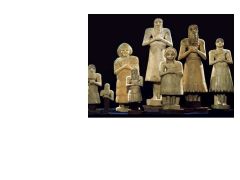
What, where, when, Art Historic significance?
|
Statuettes of worhippers
from Eshnunna (modern Tell Asmar) Iraq ca. 2,700 B.CE. gypsum, shell, black limestone tallest 30 in. high |
|
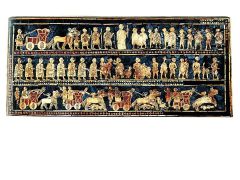
What, where, when, art historic significance?
|
Standard of Ur from Tomb 779, Royal Cemetery Ur (modern Tell Muqayyar) Iraqca. 2,600 B.C.E.
wood, shell, lapis lazuli, red limestone approximately 8 x 19 in. Royal Cemetery at Ur which was the home to biblical Abraham This was where the legends of musicians, servants, soldiers who accompanied the ‘kings and queens’, into the afterlife, giving their lives when their rulers died. Rectangular box with sloaping sides. War and Peace sides. Read from left to right, bottom to top. Note how ‘king’s’ head breaks through the register line We cannot connect the scene to a particular historical event. |
|
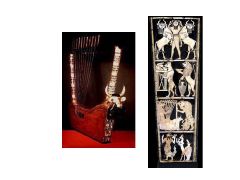
What, where, when, art historic significance?
|
Bull-headed lyre
from Tomb 789, Royal Cemetery Ur (modern Tell Muqayyar) ca. 2,600 B.C.E. wood, gold leaf, lapis lazuli approximately 65 in. high Music in the afterlife Resembles the instrument depicted in the Standard of Ur Bull’s head is gold leaf over a wooden form Details of lapis lazuli Figures similar to the animals acting like people in Aesop’s fables and Walt Disney’s creations |
|
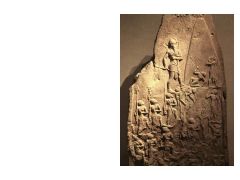
What, when, where, art historic significane?
|
Victory stele of Naram-Sin
from Susa, Iran ca. 2,254-2,218 B.C.E. sandstone 79 in. high Commemorates Naram-Sin’s conquest of the Lullubi. It is inscribed twice, once in honor of Naram-Sin and once by a Elamite king who had captured Sipur and claimed the stele as booty. |
|
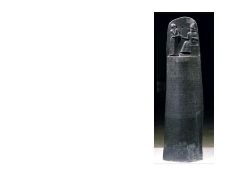
What, when, where, art historic significance?
|
Stele with code of Hammurabi
from Susa, Iran ca. 1,780 B.C.E. basalt 88 in. high. The code is inscribed on a tall black basalt stele. The top is a relief showing Hammurabi in the presence of the flame-shouldered sun god Shamash. The king raises his hand in respect and the god bestows power on the king. Combined front and side view |
|
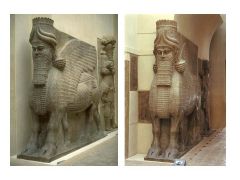
What, when, where, art historic significance?
|
Lamassu (winged human headed bull)
from the citadel of Sargon II, Dar Sharrukin (modern Khorsabad) Iraq ca. 720-705 B.C.E. limestone 13 ft. 10 in. high. Sargon II’s guardians High reliefs Front view is the animal at rest Side view is the animal walking. Has five legs |

